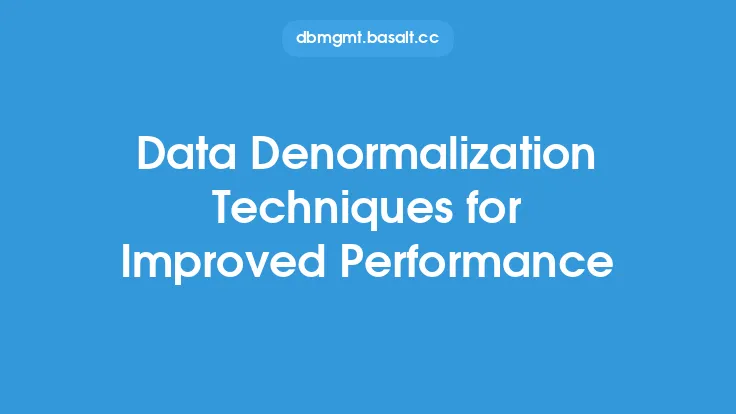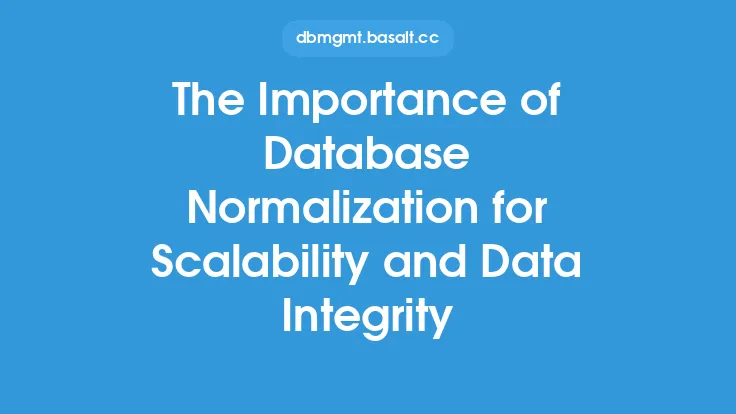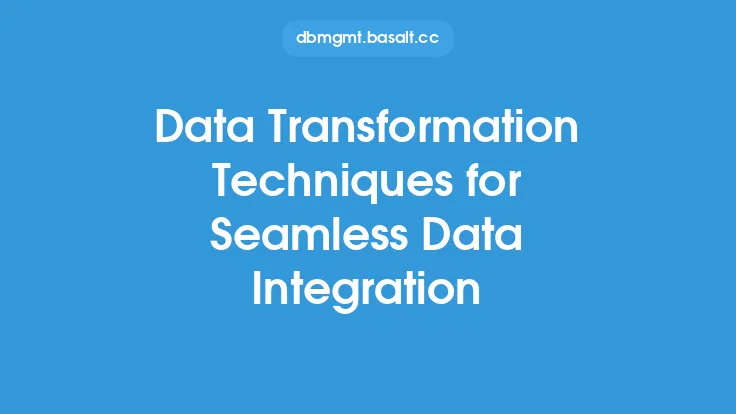Data transformation is a crucial step in the data processing pipeline, enabling organizations to convert raw data into a format that is suitable for analysis, reporting, and decision-making. The primary goal of data transformation is to improve data integrity by ensuring that the data is accurate, complete, and consistent. In this article, we will delve into the various data transformation techniques that can be employed to achieve improved data integrity.
Introduction to Data Transformation Techniques
Data transformation techniques are methods used to manipulate and convert data from one format to another. These techniques can be applied to various types of data, including numerical, categorical, and textual data. The choice of technique depends on the specific requirements of the project, the type of data, and the desired outcome. Some common data transformation techniques include data cleaning, data normalization, data aggregation, and data feature scaling.
Data Cleaning Techniques
Data cleaning is an essential step in the data transformation process. It involves identifying and correcting errors, inconsistencies, and inaccuracies in the data. Data cleaning techniques include handling missing values, removing duplicates, and data validation. Handling missing values can be done using various methods, such as mean, median, or mode imputation, or using more advanced techniques like multiple imputation or regression imputation. Removing duplicates involves identifying and removing duplicate records, which can be done using techniques like hash-based duplicate detection or sorting-based duplicate detection.
Data Normalization Techniques
Data normalization is a technique used to transform data into a common scale, usually between 0 and 1. This is useful for preventing features with large ranges from dominating the model. Data normalization techniques include min-max scaling, z-score normalization, and logarithmic scaling. Min-max scaling involves rescaling the data to a common range, usually between 0 and 1, using the formula (x - min) / (max - min). Z-score normalization involves rescaling the data to have a mean of 0 and a standard deviation of 1, using the formula (x - mean) / std.
Data Aggregation Techniques
Data aggregation involves combining multiple values into a single value. This can be done using various techniques, such as sum, average, count, and group by. Sum aggregation involves adding up all the values in a group, while average aggregation involves calculating the mean of all the values in a group. Count aggregation involves counting the number of values in a group, while group by aggregation involves grouping the data by one or more columns and applying an aggregation function to each group.
Data Feature Scaling Techniques
Data feature scaling involves transforming the data into a format that is suitable for modeling. This can be done using various techniques, such as standardization, normalization, and logarithmic scaling. Standardization involves rescaling the data to have a mean of 0 and a standard deviation of 1, while normalization involves rescaling the data to a common range, usually between 0 and 1. Logarithmic scaling involves rescaling the data using the logarithmic function, which can be useful for skewed data.
Advanced Data Transformation Techniques
Advanced data transformation techniques include techniques like data binning, data encoding, and data transformation using machine learning algorithms. Data binning involves grouping the data into bins or intervals, while data encoding involves converting categorical data into numerical data using techniques like one-hot encoding or label encoding. Data transformation using machine learning algorithms involves using algorithms like decision trees, random forests, or neural networks to transform the data into a format that is suitable for modeling.
Best Practices for Data Transformation
Best practices for data transformation include documenting the data transformation process, testing the data transformation code, and validating the results. Documenting the data transformation process involves keeping a record of all the steps involved in the data transformation process, including the techniques used and the parameters chosen. Testing the data transformation code involves testing the code to ensure that it works correctly and produces the expected results. Validating the results involves checking the results to ensure that they are accurate and consistent.
Common Challenges in Data Transformation
Common challenges in data transformation include handling missing values, dealing with outliers, and handling data quality issues. Handling missing values can be challenging, especially when the data is sparse or when the missing values are not missing at random. Dealing with outliers can be challenging, especially when the outliers are not easily identifiable. Handling data quality issues can be challenging, especially when the data is noisy or when the data is not well-documented.
Future of Data Transformation
The future of data transformation involves the use of advanced technologies like artificial intelligence, machine learning, and cloud computing. Artificial intelligence and machine learning can be used to automate the data transformation process, while cloud computing can be used to scale the data transformation process to handle large volumes of data. Additionally, the use of data transformation techniques like data binning, data encoding, and data transformation using machine learning algorithms is expected to increase in the future.
Conclusion
In conclusion, data transformation is a critical step in the data processing pipeline, enabling organizations to convert raw data into a format that is suitable for analysis, reporting, and decision-making. The various data transformation techniques discussed in this article, including data cleaning, data normalization, data aggregation, and data feature scaling, can be used to improve data integrity and achieve better results. By following best practices for data transformation and using advanced data transformation techniques, organizations can unlock the full potential of their data and make better decisions.





